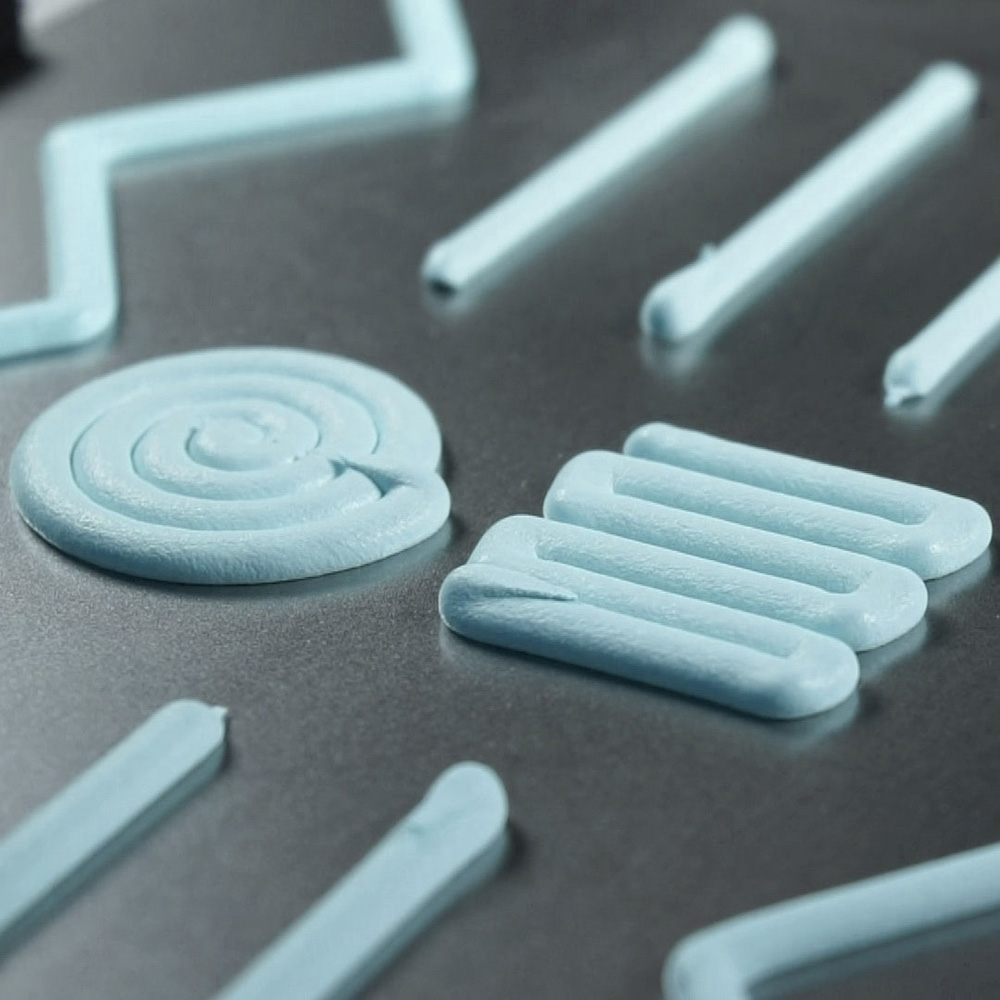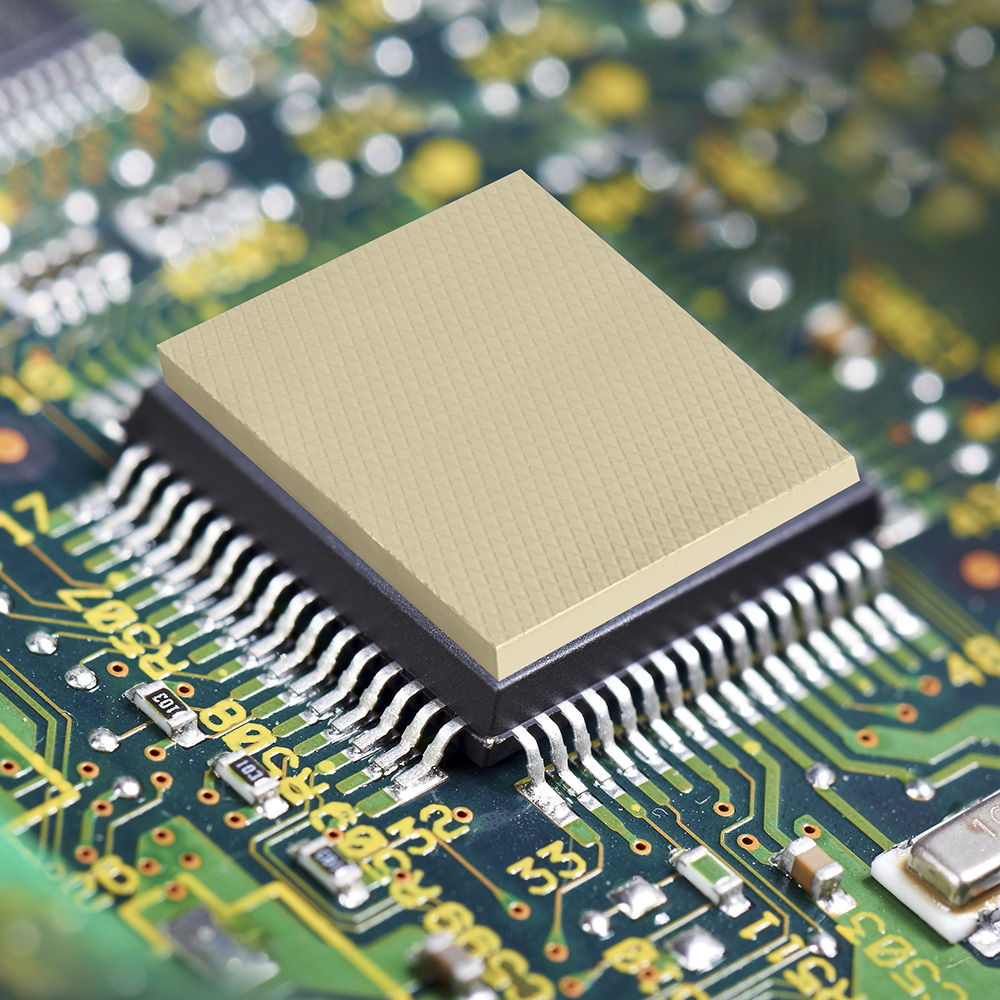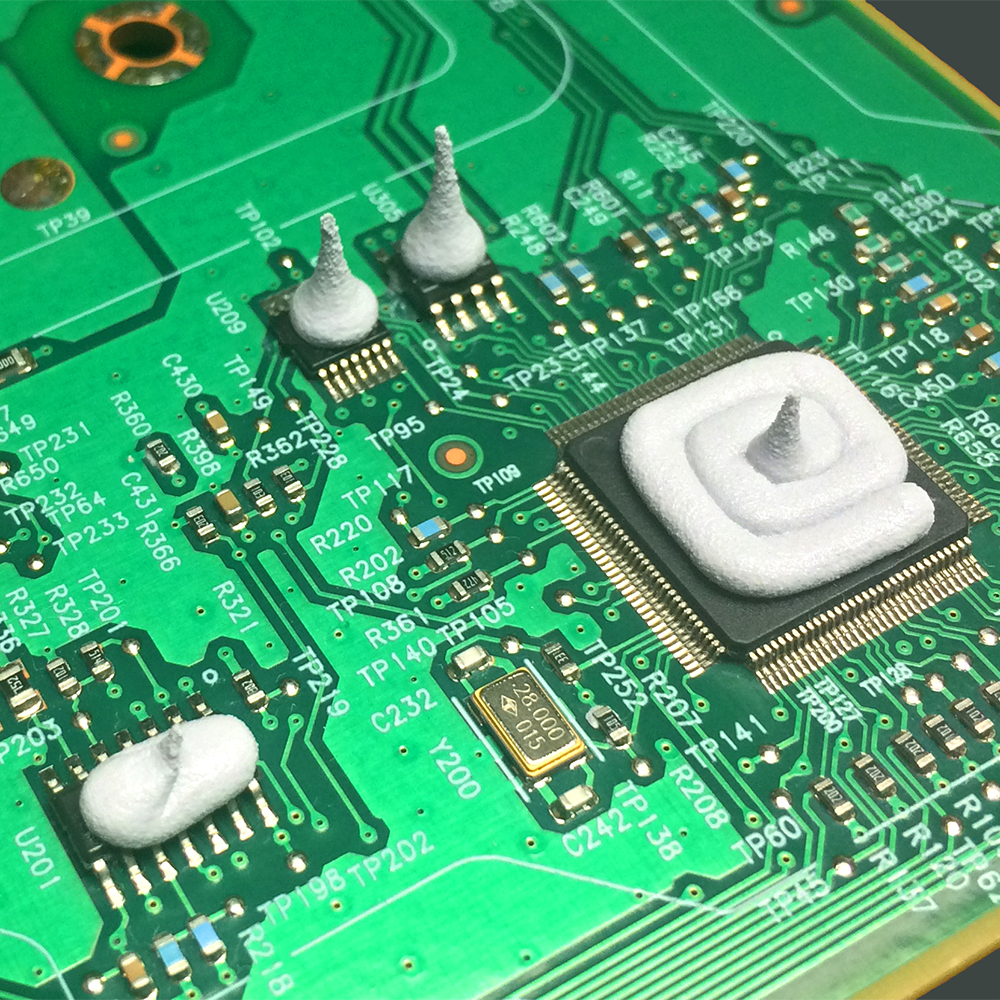
Webinar: Selecting a Thermal Gel or Thermal Gap Pad
Which thermal interface material is best for your application? Our experts break it down on this recent technical webinar.
Discover how to select a thermal gel or thermal pad with this on demand webinar.
- How to determine which thermal interface material is right for you
- The benefits of each - a dispensable gel or gap pad and what you need to know about them
- Determining your requirements and selecting a material that best suits your application
Transcription
All right, it seems like everyone has had time to join us and we are now ready to begin. Thank you. So just a little housekeeping before we start. You should be in listen only mode already, but now is a good time to check to make sure before we get started. You will be able to ask questions during the webinar using the chat feature. As you can see, the chat feature is located on the webinar panel here. Our subject matter experts will answer all of your questions at the end of the webinar. Please be aware that we are not accepting anonymous questions, so if you do ask one, your name will be visible.
Should we run out of time for questions or just not get to them all, rest assured, we will be happy to follow up with you after the webinars over. And finally, this webinar will be recorded and automatically will be sent to you after the session. So with that, let's begin.
Hello and welcome. My name is Callie King and I'm the thermal product line manager at Parker Chomerics and I've been with the team here for six years.
Hi, everyone, my name is Ben Nudelman, I'm a market development engineer for Chomerics and have been with the team for three years.
We'll start today with a brief introduction about Chomerics and then continue into thermal theory basics. We'll discuss the critical properties of thermal gap pads and gels and talk about dispensing considerations. And finally, we will end with a few case studies, have some time for question and answer at the end of the webinar. Chomerics division is part of the Parker-Hannifin Corporation Engineered Materials Group and is a global leader in the development and application of electrically conductive and thermal interface materials. Engineers and designers from every industry, including aviation, telecommunications, life science, defense, commercial and consumer electronics, choose Chomerics for its strong product portfolio, utilizing technology built on core competencies in material science and process technology.
Our first section is going to go into some details about the background of thermal theory to help you best select which materials to use for your application.
All right, then we'll hear a refresher. Basically, the point of this slide is talking about how thermal interface materials are meant to serve in the interface between a heat generating component and a cold plate or a cooling feature. And then they're meant to be better than air solutions because air is a good insulator. Throughout this presentation, you will hear us refer to thermal interface materials as TIMs as they're often referred to. Thermal interface materials are just that. Materials meant to transfer heat at the interface between the heat generating component and a cooling feature.
Heat generating components can be anything from semiconductors or batteries to large electronic assemblies while heat sinks or housings or enclosures can serve as cooling features.
TIMs use conduction to pull heat away, relying on contact between components to remove interstitial air gaps. Densely packed ceramic particles within silicone binder's give TIMs excellent durability and thermal connectivity while ensuring electrical insulation and no concern of shorting electrical leads.
Thermal conductivity and thermal impedance are two properties that are most commonly used to describe the performance of thermal interface materials. Thermal conductivity is a bulk material property, and it's used to compare the ability of the material to transfer heat. It's also most commonly used to compare across competitive materials. Callie, how's that different from thermal impedance?
Thermal impedance is different, and that is the real world property that demonstrates material performance based on part thickness and application specific pressure. The thermal impedance takes into account the important factor of thermal contact resistance, which is the decrease of thermal transferability at the interface between the TIM and the heat generating component.
Across all industries and nearly all applications, we see pretty common drivers for the use of thermal interface materials. As boards get hotter and enclosure's get smaller, higher performance density and greater use of application drive continuous improvement. Callie, of the properties on the slide, have you seen specific drivers influence customer decisions?
Certainly. So typically customers come in and they want the best performing or the highest thermal conductivity material, which correlates to the lowest thermal impedance material. But just going for the best thermal material doesn't always meet their application needs. So there are other physical and regulatory properties to discuss when deciding on a thermal interface material. For instance, having the greatest conformability in a product is highly desirable, since that helps wet out on each service and really drives the thermal performance of the material.
And also it's really important to determine how the material is going to be applied in final manufacturing processes. For instance, whether the customer wants to have the material manually assembled onto a part or through automation.
Thermal gap pads and thermal gels are the two most common types of TIMs. Throughout the rest of this presentation, we'll talk about the specific properties of gap pads, the specific properties of gels and then get into examples of case studies where each is an ideal solution.
Now we're going to get into some of the properties of the thermal gap pads.
Those gap pads are designed to be soft and reduce component stress. The advantage of this component ability is that it actually provides vibration dampening and gives gap has a large enough compression range to pick up tolerances. We recommend, for example, gap pads be compressed anywhere from five to 40 percent of the total gap height.
The gap pads are also offered in a wide range of sizes and thermal performance. From the size perspective, the gap pads are offered anywhere from small custom die cut parts based on customer supplied drawings or can be offered in sheet format, either 18 by 18 sheets or even some of the materials up to twenty by twenty five inch sheets. From a thermal perspective, the materials offered from one to six and a half W/m-K, and these are also offered with a variety of different carriers for the material, which we'll get into a little bit on the next slide.
The materials are also offered anywhere between ten thousand seven inch, up to two hundred thousand seven inch, depending on which material you need to best suit your application.
Callie, even though the standard thicknesses go up to two hundred thousandths, have we seen gap pads go above that?
Yeah, we have. Some applications actually require up to half an inch thickness. So for most materials, we can go thicker as need be.
And I guess what's the advantage of the gap pads passing low outgassing according to NASA testing?
Having the materials pass NASA outgassing is an important requirement for the customers who either have the gap pads going into vacuum or space applications or even when the material is near some sort of camera optical component. Having a low outgassing means that the silicone that is outgassed won't actually condense onto the camera or in any other component within that compartment where it could be detrimental in an optical setting.
Callie, you mentioned some of the carriers that gap pads can be provided on, can you list some of them?
Yeah. So, for instance, we offer them on aluminum carriers, which have a PSA on the back side of it for permanent attachment to a component. We also offer on fiberglass, PEN film, Kapton and sometimes even no carrier on the material itself.
So the aluminum ones are the only ones that come with a pressure sensitive adhesive, right?
That's right. So for any application where you actually don't need to have the material attached to the component, we would recommend using one of the other films. Typically, the fiberglass carrier is the most commonly one used.
So, what would be an example of the benefit of the Kapton or the PEN film?
Well, Kapton and PEN film are used in applications where there's any type of shearing that could occur. So these films are shear resistant and the advantage of using the Kapton carrier over the PEN film is that the Kapton carry is actually thermally enhanced. So it actually boosts the thermal conductivity or lowers the thermal impedance of the pad itself.
Now we're going to get into some of the properties of thermal gels, the other common thermal interface material.
Thermal gels are one component, dispensable products that once they are dispensed down onto your board or application, they don't require any secondary cure operation and they stay conformable over the lifetime of the product. Ben, why would this be helpful versus a gap pad material?
One of the big advantages of gels over gap pads is in terms of the supply chain. For example, if you have a board with various types of components and a single height key sink, you've got various gap pads that need to that need to be used in order to meet the thermal requirements of each of those components. Whereas with a gel you can just dispense different amounts of gel to take up that nominal tolerance without having to change over different parts or maybe provide drawings of different applications.
At the same time, we've got gels that have thermal performances up to seven and a half W/m-K in terms of their thermal conductivity. An important thing to note is, because of the gels properties of dispensing and wetting out, we've actually seen gels with lower conductivities actually outperform higher conductivity pads. For example, a three W/m-K gel may actually outperform a five W/m-K pad, depending on how it's used and how it's placed in the application.
So, you say that customers can dispense this down their shock and conformable. How can you assure me that that's still going to be reliable on application? For instance, if I'm going to have high vibration applications or the application is actually going to be vertical in the real world.
That's a good question. Gels were actually originally developed for the automotive industry, where you see a lot of vibration and a lot of vertical applications of some of the internal components. The gel is specifically designed not to pump out or flow and to be stable in long term testing through through vibration and through long term aging.
All right. That's good to know and helps. So when you say there's dispensing applications here, how does a customer know what equipment to select for dispensing and when should that be used?
That's one thing that we'll get into a little bit later in the presentation with some examples of the what dispensing equipment looks like. Callie, one of the things that that we commonly see or are asked questions about is the difference between viscosity and flow rate, especially considering a gel is a you know, seems to be a more viscous material. Can you explain the difference between viscosity and flow rate?
Yeah, so it's commonly asked to supply viscosity measurements for each of our gel components so customers can then put it into some sort of simulation software. But the problem and why we do not publish viscosity data and instead publish a flow rate is to better suit the material itself. The gel materials are actually viscoelastic and that means that they change properties over time and they have shear tendencies. So if we were to measure viscosity, the material would just continue to shear over time and it wouldn't be representative in an end application.
So instead we publish a flow rate measurement and the flow rate is actually the amount of material that dispensed from a syringe under 90 PSI for a minute length of time. And this is really more representative for a customer and how they're going to use it in their end application.
This seems like a perfect time to talk about a new product Parker Chomerics will be launching soon. It's the highest performing dispensable yet, and it's called Gel 75. Seventy five indicating that it's a seven and a half W/m-K material.
Yeah, we've been developing this material for quite some time now in response to the future high power demand, the 5G enabled telecom infrastructure application. Its flow rate is nearly five times faster than that of its closest performing dispensable material that Chomerics currently offers at five W/m-K. So combining the flow rate capabilities and the excellent thermal conductivity, we think this material is really going to improve applications from a performance and reliability standpoint.
We're really excited to get to get this to the market and it should be available in the next few weeks, in the summer of 2020.
Now we're going to get into a section about the dispensing guidelines and parameters that customers should look for when selecting dispense equipment.
When it comes to dispensing thermal gels and putties, there's a lot of tips and tricks as well as considerations to take into account, all of which can be found in our thermal interface material dispensing guide. One of the things that you see here on the slide are dispensing patterns and what they look like before and after compression. It's important to think about this as you need to know what gaps are going to look like and how much space you want to take up after the gel is compressed.
Callie, what are some other dispense considerations?
There are a few other important parameters to consider as you're looking at your part to dispense on to. First and foremost, the part needs to be cleaned off prior to dispensing any sort of gel material down to free Assad, and it can be cleaned off with a simple IPA or a solvent solution. Second, it's also important to make sure the surface has proper surface roughness. This will not only help the material wet out and have better thermal performance performance against the part itself, but it'll also help for long term reliability.
And one of the other important aspects is to consider the dispensing technique, which we'll get into a little bit more in terms of what type of equipment to select, but also just the shot size repeatability and how to apply the material down onto a part.
Callie, it's also important to note that our gels and putties come in a variety of different packages that can be provided based on the optimal dispensing, right?
That's right. We offer sample small ten CC manual syringes that customers can use to sample and test on to their parts. But then from a manufacturing standpoint, we offer syringes from 30 CC syringes, up to 20 ounce cartridges and even in one and five gallon pails for larger applications.
There are a few different levels when it comes to the dispensing equipment ranging in cost, as well as the different specific applications that they're meant for each of them having specific pros and cons. Callie, can you talk about the lowest cost level of dispensing equipment?
Sure. So customers can purchase a manual shot size controller, which ranges anywhere from four hundred dollars to two thousand dollars. And these are relatively inexpensive systems that sit on the tabletop and an operator can manually apply materials through the syringe onto a part just simply using air pressure. But then why would someone want to use the next level up or have a higher expense when purchasing their dispense equipment.
Yeah, the next level is typically referred to as a tabletop dispenser or robotically controlled dispenser. While the cost is a little bit higher and there is some setup and material change over time required between between runs, the pros are that you can typically work with more complex geometries and get more repeatability in terms of the the control of the robotic dispensing of the gels on specific parts. This means you can swap out boards and in general limit the amount of time it takes to dispense each part. Callie, what about the next level up, the one that's a little bit more expensive than that? Because obviously more more advantages.
Yeah, so these robotically controlled systems are really going to be much more cost prohibitive compared to the lower end models that we just discussed, but they come with great advantages. So instead of having a time pressure system where your shot size variation is not as tightly controlled as you wish, you can purchase systems that actually come with a precise belt that will help in controlling your shot size variation. So these systems are typically geared towards your larger cartridge sizes or your one or five gallon pails and using high volume automation. Pulley systems typically come with sensors on the part itself that you have fiduciary recognition. You can weigh the parts, the material dispensed on each part and have better control of your system.
Callie, when you mention high volume manufacturing, what type of volumes are you typically looking at for those precision valves and pump systems?
These are typically systems where customers are dispensing five or more days per week on multiple shifts. So you could consider these being more like your 10,000 parts per year or greater than that. Here's a video showing gel 30 being dispensed from a precision valve in a variety of different patterns. This is one of the most popular products that Chomerics offers, and it's been used in the market for over 10 years now.
While gap pads and gels share a lot of similarities like conformability, orientation independence and product reliability, supported by years of material development and testing, there are some key differences in deciding which solution is the right one for a given application. Callie, can you talk about some of the features making gels an ideal solution?
Of course, those gels are typically used in high volume applications where customers really need an automated process or high precision shot size repeatability. And typically, these are also used in applications where customers need low compression force, meaning that once the gel is compressed down, there isn't much force on the components themselves or if the application requires a very thin bond line. So less than a quarter of a millimeter, the gels have the ability to go down to a very small bond line even without having any sort of electrical shortage or any or any electrical issues.
Ben, why would customers prefer a gap pad over a thermal gel?
Yeah. So on the other hand, gap pads lend themselves far better to manual assembly. It's more of a peel and stick application where they can be placed manually as opposed to using any kind of robotic equipment. Additionally, gap pads, considering they're available in 18 by 18 sheets, have the advantage of being able to cover a large continuous area while they can also be die cut to to meet complex geometries. Thicker gap pads, as we've touched on, can provide a lot of vibration dampening in applications that require it could see vibration, whether that's defense, aerospace or automotive, for example.
Also, gap pads tend to have the advantage of being available up to relatively thick bond lines and being able to take up tolerances. Our last section before the question and answer session is going to be a few case studies on examples of where gap pads or where gels would be the solution and what factors are driving this. Just as in every quickly advancing and innovating industry, you see quite a bit of demand for thermal interface materials in defense and aerospace applications. This can be everywhere from avionic boxes and flight control modules to electronic warfare pods, satellites and even ground and air based radar systems.
Ben, can you give a specific example of when a customer would use a TIM in their application?
Yeah, a perfect example for gap pads is actually in the use of cooling large radar arrays where you've got hundreds of individual radar elements sitting close together in a grid. A gap pad would be designed with cutouts or a certain shape to reduce the weight, all built to a customer drawing.
That's a great example. And it looks like in this image from the gap pad shown here that there's actually PEN film applied on the gap pad itself. Can you explain why the customer needed that for their application?
Yeah, of course. The PEN film actually helps in terms of shearing and gives durability over the lifetime of the array. It just helps the gap pad maintain its thermal properties over the course of the scheduled maintenance that would be required on the arrays.
Great. And it looks like these parts are quite complex and unique to the application itself. What's the design flexibility like with the customer and what kind of customization is there available to them?
Yeah, there's a lot of design flexibility. We can die cut or XY cut to just about any customer drawing, and we hold pretty tight tolerances when it comes to specific pattern locations as well as overall dimensions of the sheet. This slide demonstrates a few of the technologies, including LiDAR, ADAS and infotainment, that have the potential to utilize thermal gap pads and dispensable thermal gels in the temperature management applications for the automotive market. Callie, can you give an example of an automotive case study where we see thermal management products used in ADAS or advanced driver assistance systems?
Certainly, it's become more and more common to use thermal management products or TIMs in these ADAS systems. Historically, there's only been a few sensors on the cars, but as they progress, more and more and more and an increased amount of sensors are needed per vehicle. There's now an increased power density and therefore a larger need for sensors and therefore the TIM material itself. So typically customers come to us where they've been using gap pads and there's been a lower volume need for gap pads.
So, the process been very manual on applying one gap pad down per vehicle, for example. But now that there's multiple sensors on a car, the questions come to us and say, "how can we automate this process and how do we switch from a gap pad to a gel in our process and keep price competitive?"
Can you talk a little bit more about that price competitiveness?
Yeah. So when customers use a pad, that means they need an operator or multiple operators to be taking the pads from the sheet or however it's formatted and supplied to them and placing it onto the part itself. And as the volume ramps up to be thousands of parts or even a million, this becomes very labor intensive and leads to a chance to have operator error. But we become more price competitive when the customer can then have some upfront cost in the dispensing equipment, but then automate the entire dispense line so they can just dispense down the gel material.
Callie, have there been any reliability concerns in switching from a gap pad to a gel?
That's a really good question and a common concern from automotive customers knowing that pads can be placed on with an adhesive and they won't fall out of the gap. There's a lot of considerations to take into account when designing in a gel. So it's important to the customer work with us and our applications team to design the gel end properly. For instance, we need to make sure there's the proper gap height to certain surface roughness and that they're dispensing the material on there properly.
But we do run reliability tests internally, which accommodate a range of gaps, as well as a series of environmental testing, including heat and humidity, thermal cycling, vibration and temperature shock to make sure that our gel materials are stable in these aggressive environments.
The telecommunications industry is another common industry for our TIM materials. Applications such as handheld wireless devices, cell phone infrastructure, satellite communications, GPS's all require a high degree of thermal management in a lot of their devices. Callie, what kind of challenges do we typically run up against in this industry?
Typically with telecommunications customers are looking for the cutting edge technology, so they're looking for the highest thermal performance material that we have. But also one of the main challenges comes to needing materials that can accommodate smaller, smaller gaps, especially if you think of like a cell phone or laptop that are becoming smaller and more compact.
We need materials that meet those same minimum bond line thicknesses and still have high thermal performance. In addition to that, most of the manufacturing done in the telecommunication market is in Asia. So I just want to bring up that we do have global support here and we can work between our US, European and Asian teams to help support the entire process. In addition to the markets that were previously mentioned, we also can use these TIM materials in other markets, including I.T., renewable energy, general industrial and life science.
Within the IT space, computers, printers and personal GPS units are all pretty common applications. As renewable energy continues to expand and grow, wind turbines, solar panels and specifically LED lighting use varied solutions of thermal interface materials for heat management. General industrial applications can include audio amplifiers and home audio equipment and the life science space, defibrillators, ventilators and other portable electronic equipment all use thermal interface materials to ensure long product life.
At the division headquarters located in Woburn, Massachusetts, we have our applications engineering support team, and within here they can help design in both our thermal management products as well as our EMI products. But specific to the thermal gap pads and gels we've been discussing, they can help provide samples and prototype parts. So as you can see imaged here, we have an array of different dispense equipment within the lab. Chomerics does not partner with any defense vendor in particular.
However, we want to have a wide range of options for our customers when implementing their own dispense equipment. So customers can either supply us parts where we then dispense directly onto them and ship them back so they can see how the thermal interface material works on their part, or we can have customers come in on site to observe and learn about the equipment and all the different options that they have available to them.
Hopefully, this webinar helped you understand some of the differences between thermal gap pads and thermal gels, as well as some of the similarities. As a brief recap in determining which solution is best for your application, we'll do a final summary here. While gap pads are typically used in a manual assembly process, thermal gels tend to be used in automated equipment that has high volume applications. At the same time, gels are used in complex geometries or various gap heights, whereas gap pads tend to be used in large continuous areas or die cut sheets.
Rather, the gap pads are also used for vibration dampening, and this is due to how soft and conformable they are, but yet still have some back pressure on the component itself. Whereas thermal gels are really needed when there's very low compression force in the application itself. The gels can also be used in very thin bond line applications, so less than a quarter of a millimeter, whereas the gap pads can be used in applications where you need a much wider gap to be filled.
As we discussed before, they can go up to two hundred of a thousandths inch or even up to a half an inch if needed.
Thank you very much for watching this webinar. And now we'll open up the call to any questions you may have.


Learn About Thermal Interface Materials from Parker Chomerics
- New product releases
- Updated support documentation and articles
- Existing product notifications
- The latest white papers, videos, and much more!




